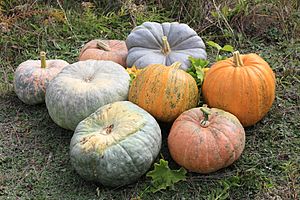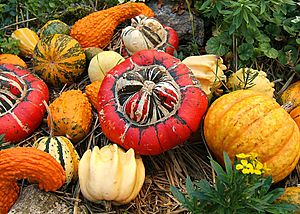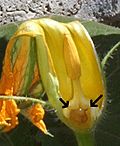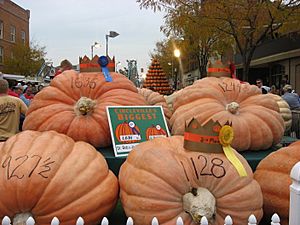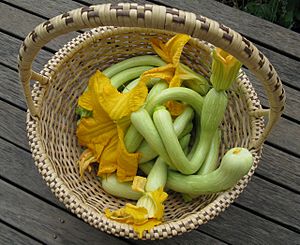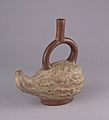Squash (plant) facts for kids
Quick facts for kids Squash |
|
|---|---|
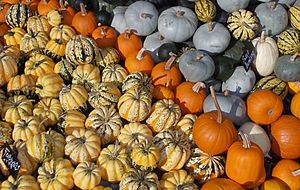 |
|
| Cucurbita fruits come in an assortment of colors and sizes. | |
| Scientific classification | |
| Synonyms | |
Cucurbita is the scientific name for a group of plants that includes many types of squash, pumpkins, and gourds. The word Cucurbita comes from Latin and means "gourd." These plants are vines that belong to the gourd family, called Cucurbitaceae. They originally grew in the Andes mountains and Mesoamerica (Central America).
People around the world grow five main types of Cucurbita for their tasty fruits and seeds. You might know them as squash, pumpkins, or gourds. Other types of gourds, like bottle-gourds, come from Africa. They are used to make tools or containers, and their young fruits can also be eaten.
Most Cucurbita plants are vines that can grow many meters long. They have special curly parts called tendrils that help them climb. Some types, like certain C. pepo and C. maxima plants, grow as "bushes" instead of long vines. Cucurbita plants have yellow or orange flowers. There are two kinds: female flowers that grow the fruit, and male flowers that make pollen. Bees and other insects help these flowers make fruit by carrying pollen from one flower to another.
Scientists still discuss how to group all the different Cucurbita species. There are between 13 and 30 accepted types. The five main types that people grow are Cucurbita argyrosperma, C. ficifolia, C. maxima, C. moschata, and C. pepo. All of these can be stored for months after they are picked, so they are often called winter squash. However, some C. pepo types are best eaten when they are young, like summer squash.
The fruits of Cucurbita plants are full of good things for you, like vitamin A and vitamin C. People use them in many recipes, from pumpkin pie to soups, breads, and desserts.
Contents
What Do Squashes Look Like?
Cucurbita plants can be divided into two main groups. The first group includes plants that live for one year or a few years. They need a steady supply of water. The second group includes plants that live for many years in dry places. These plants can handle very dry conditions. The types of Cucurbita that we grow today came from the first group.
These plants can grow from 5 to 15 meters long. They have tendrils that help them climb other plants or structures, or spread along the ground. The vines of older Cucurbita plants can become a bit woody. The fruits of Cucurbita come in many different sizes, shapes, and colors, even within the same type of squash! For example, C. pepo and C. maxima have so many different kinds that people sometimes mistake them for completely different species.
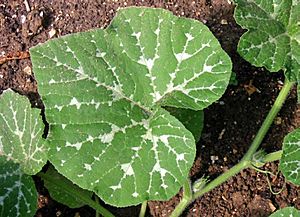
Most grown Cucurbita plants have leaves with five lobes, like a hand with fingers. These leaves grow one after another along the stem. The stems can be angled in some types. All parts of the plant above ground might be hairy with tiny, often sharp, hairs. Curly tendrils grow from where the leaves meet the stem.
The leaves of different Cucurbita species can look different. For example, C. argyrosperma has egg-shaped to heart-shaped leaves. C. pepo leaves vary a lot in shape. C. moschata plants can have light or thick hairs on their leaves. The leaves of C. ficifolia are slightly angled and have light hairs. Many of these leaves might also have white spots.
Flowers and Fruit
Cucurbita plants have both male and female flowers on the same plant. These flowers grow alone from the places where leaves meet the stem. The flowers have five yellow to orange petals that are joined together, and a green, bell-shaped base. Male flowers usually have five pollen-making parts called stamens, but in Cucurbita, there are only three, and they are joined, so it looks like there's just one. Female flowers have a thick stem and a part at the bottom that will become the fruit. They also have 3-5 sticky parts called stigmas, each with two lobes.
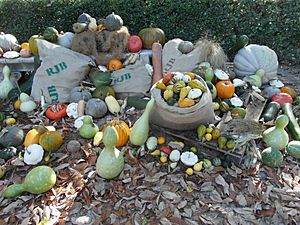
Cucurbita fruits are large and fleshy. Botanists call the Cucurbita fruit a "pepo." This is a special type of berry that grows from the bottom part of the flower. It has a thick outer skin and a fleshy inside. The seeds are large and flat, and they are attached to the inner wall of the fruit.
The size of the fruit can be very different. Wild fruits can be as small as 4 centimeters (about 1.5 inches). Some grown fruits can weigh more than 300 kilograms (about 660 pounds)! The biggest pumpkin ever recorded weighed over 2323 kilograms (5,123 pounds) in 2014!
How Squashes Are Grouped
The famous scientist Carl Linnaeus first officially described Cucurbita in 1753. He included C. pepo (which is the main type for the group), and other plants like watermelon and bottle gourds, which are in the same plant family but are not true Cucurbita.
Scientists group Cucurbita species in different ways, from 13 to 30 types. In 1990, an expert named Michael Nee grouped them into 13 main types, with 27 species in total. Here are some of the main groups and where they came from:
- C. argyrosperma (also called cushaw pumpkin) – from Panama and Mexico.
- C. digitata (fingerleaf gourd) – from the southwestern USA and northwestern Mexico.
- C. ecuadorensis – from Ecuador.
- C. ficifolia (figleaf gourd) – from Mexico, Panama, Chile, and Argentina.
- C. foetidissima (stinking gourd) – from Mexico.
- C. maxima (winter squash, pumpkin) – from Argentina, Bolivia, and Ecuador.
- C. moschata (butternut squash) – from Bolivia, Colombia, Ecuador, Mexico, and other parts of Latin America.
- C. pepo (field pumpkin, summer squash, zucchini) – from Mexico and the USA.
The five types that people grow are usually separate from each other because they don't easily cross-pollinate. However, some cross-pollination can happen between C. pepo and C. argyrosperma or C. moschata. Also, C. maxima can cross with C. moschata.
Reproduction and Life Cycle
All Cucurbita species have 20 pairs of chromosomes. Many types in North and Central America are pollinated by special bees called squash bees. These bees are very important for the flowers to produce fruit.
When more pollen lands on a female flower, the fruit will have more seeds and grow larger. This is called "xenia." Farmers who want to grow giant pumpkins often hand-pollinate them to make sure they get as many seeds as possible, which helps the fruit grow huge.
The plant's age and whether it already has fruit growing are important for flowering and fruit production. Plant hormones like ethylene and auxin play a big role. Ethylene helps the plant make more female flowers. If a plant already has a fruit growing, new female flowers on that plant are less likely to grow into fruit. This is called "first-fruit dominance."
Another plant hormone, gibberellin, is needed for male flowers to develop. Gibberellin also helps with other plant growth, like seeds and stems.
How Seeds Grow
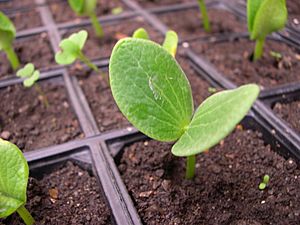
For seeds to grow best, they need to be fully developed. For example, in C. moschata, seeds are ready to grow about 45 days after the flower opens. The seeds reach their heaviest weight about 70 days after the flower opens.
Some types of C. pepo seeds grow best with eight hours of sunlight each day. They should be planted about 1.2 centimeters (half an inch) deep. Seeds planted deeper than 12.5 centimeters (about 5 inches) might not grow.
Studies show that when more pollen is put on a flower, not only does the fruit get bigger and have more seeds, but the seeds also sprout faster and are more likely to grow. The young plants (seedlings) also become larger. Different amounts of nutrients and light can affect how the plant grows at different stages.
Where Squashes Grow
Scientists have found proof that people started growing Cucurbita over 8,000 years ago. This happened in places from southern Canada all the way down to Argentina and Chile. The main areas where they were first grown include the Mississippi River area, Texas, Mexico, Central America, and parts of South America.
Out of the 27 types of Cucurbita, five are grown by people. Four of these, C. argyrosperma, C. ficifolia, C. moschata, and C. pepo, first grew and were domesticated in Mesoamerica (Central America). The fifth one, C. maxima, was first grown in South America.
Within the C. pepo group, pumpkins, scallops, and crooknecks are very old types that were grown at different times and in different places. The pumpkins we grow today have bigger fruits and larger, but fewer, seeds than their wild relatives.
C. argyrosperma is not as common as other types. Its wild form is found from Mexico to Nicaragua. People probably grew it for its large seeds, which are rich in oil and protein. Its flesh is not as good as C. moschata or C. pepo. It can grow in many different altitudes, from sea level up to 1,800 meters (about 5,900 feet).
C. ficifolia and C. moschata were once thought to come from Asia, but this is not true. They actually came from Latin America, most likely southern Mexico, Central America, or the Andes. C. ficifolia grows at high altitudes, from 1,000 to 3,000 meters (about 3,300 to 9,800 feet), in places with a lot of rain.
C. maxima started in South America over 4,000 years ago, probably in Argentina and Uruguay. These plants don't like frost and prefer bright sunlight and soil that is slightly acidic to neutral. C. maxima didn't spread to North America until after Christopher Columbus arrived. Native peoples in the United States were using different types of C. maxima by the 16th century.
C. moschata is from Latin America, but its exact origin is not certain. It has been in Mexico, Belize, Guatemala, and Peru for 4,000–6,000 years. It has also spread to Bolivia, Ecuador, Panama, and other places. This type is closely related to C. argyrosperma. A type called Seminole Pumpkin has been grown in Florida since before Columbus. It usually grows in warm places with lots of rain, but some types can be found at higher altitudes.
C. pepo is one of the oldest types of squash grown by humans. The oldest known places where it was grown are Oaxaca, Mexico, about 8,000–10,000 years ago, and Ocampo, Mexico, about 7,000 years ago. It appeared in Missouri, United States, at least 4,000 years ago. C. pepo can grow from sea level up to 2,000 meters (about 6,500 feet). Its leaves have 3–5 lobes and are 20–35 centimeters (8–14 inches) wide. All the different types and varieties of C. pepo can cross-pollinate with each other.
In 1986, botanist Harry Paris suggested a way to group the edible types of C. pepo based on the shape of their fruit. There are eight main groups, and almost all C. pepo types fit into one of them. There is also one type that is not eaten, called C. pepo var. ovifera, which is grown for decoration.
| Cultivar group | Botanical name | Image | Description |
|---|---|---|---|
| Acorn | C. pepo var. turbinata |  |
A winter squash that can be a bush or a vine. It's shaped like a spinning top, pointed at the end, with grooves. Example: Acorn squash. |
| Cocozzelle | C. pepo var. Ionga |  |
A summer squash with a long, slender, round fruit that is slightly wider at the end. |
| Crookneck | C. pepo var. torticollia (also torticollis) |  |
A summer squash that grows on a bush. It has yellow, golden, or white fruit that is long, curved at the end, and often has a bumpy skin. Example: Crookneck squash. |
| Pumpkin | C. pepo var. pepo |
 |
A winter squash that grows on a vine. It's round, flat, or oval. Example: Pumpkin. This group also includes a type used for pumpkin seed oil. |
| Scallop | C. pepo var. clypeata; called C. melopepo by Linnaeus |  |
A summer squash that prefers a semi-bush habitat. It's flat or slightly disc-shaped, with wavy edges. Example: Pattypan squash. |
| Straightneck | C. pepo var. recticollis |  |
A summer squash that grows on a bush. It has yellow or golden fruit with bumpy skin, similar to the crookneck but with a straight stem end. Example: Straightneck squash. |
| Vegetable marrow | C. pepo var. fastigata |  |
Summer and winter squashes that can be vines or semi-bushes. They are cream to dark green, short, and round with a slightly wide end. Example: Spaghetti squash (a winter type). |
| Zucchini/Courgette | C. pepo var. cylindrica | The most common group of summer squashes today, developed in the 1800s. They are semi-bush plants with cylindrical fruit that has a mostly consistent width. Example: Zucchini. | |
| Ornamental gourds | C. pepo var. ovifera | 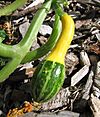 |
Not edible. These are wild squashes closely related to C. texana. They grow on vines and have thin stems and small leaves. There are three subgroups: egg-shaped or pear-shaped, orange, and round warty gourds. |
Images for kids
-
Cucurbita pepo subsp. texana, from the Grandes Heures of Anne of Brittany, 1503–1508, f. 161, earliest depiction of cucurbits in Europe.
-
Moche squash ceramic. 300 C.E. Larco Museum.
-
A pyramid of squashes in the Waterlily House, Kew Gardens, 2013.
See also
 In Spanish: Cucurbita para niños
In Spanish: Cucurbita para niños


